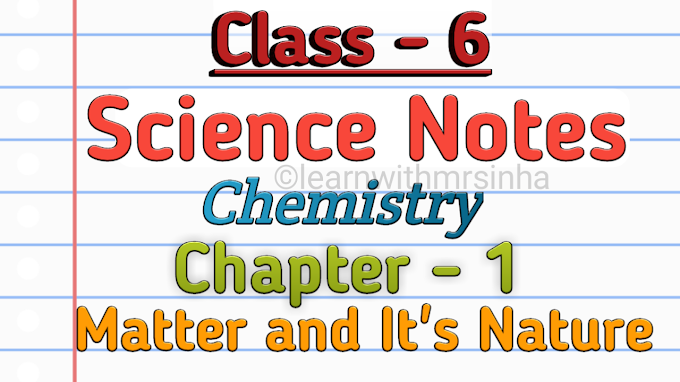Separation of Substances
Science Notes
Class
6
Mixture :- Mixture is the substance that can separate into two or more substances by simple physical means.
Components :- The pure substances that make up a mixture are called the components or the constituent of the mixture.
Mixture on the
basis of State of Constituents
Solid Mixture Mixture of two or more solids
Liquid Mixture Mixture of two or more liquids
Gaseous Mixture Mixture of two or more gases
Solid-liquid mixture Mixture of two or more solids and liquids
Liquid-gas mixture Mixture of two or more liquids and gases
Mixture
Usually Classified on the basis of the state of the constituent.
Homogeneous Mixture :- A mixture in which solute and solvent are mixed uniformly. In this mixture solute completely dissolved or mix in solvent and becomes disappear.
Ex.- mixture of water and salt.
Heterogeneous Mixture:- A mixture in which the components of the mixture are not uniform. In this mixture solute can't mix or partialy mix in solvent and can be seen easily.
Ex.- Mixture of sand and Water.
|
Type |
Homogeneous |
Heterogeneous |
|
Solid |
All alloy Stainless Steal |
Rice + Stone, Salad, Chalk + Sugar |
|
Liquid |
Solution of spirit in water |
Oil + Water |
|
Gaseous |
Air (Mixture of all gases) |
- |
|
Solid – Liquid |
Solution of salt in water |
Sand + Water |
|
Solid – Gas |
- |
Smoke (Soot + Air) |
|
Liquid – Gas |
Air dissolved in water, Fizzy drink (CO2 dissolved in water) |
Mist (droplets of water + Air) |
Why Separation
· To remove undesirable constituents.
· To obtain desirable substances.
· To obtain highly pure substances.
Methods of
Separation
1. Hand-Picking
2. Winnowing
3. Sieving
4. Magnetic Separating
5. Sedimentation and Decantation
6. Filtration
7. Churning
8. Evaporation
9. Distillation
10. Dissolution and Evaporation
Separation of Mixture
Hand-Picking
If a constituent of a solid mixture is big and visibly different.
Ex:- Separating Stone from rice
Science Notes Class 6
Winnowing
When one constituent is light and another is heavy.
Ex:- Separating Chaff (the covering of grain) from grain
Sieving
When particle size of constituents are different.
Ex.- Separating stone from sand.
Magnetic Separation
If a constituent of a mixture contains iron substance.
Ex.- Separation of scrap iron from scrap yard.
Sedimentation and Decantation
Ex :- Process of removing water from the mixture of and sand water (Sedimentation)
Sedimentation :-
Sedimentation is a physical water treatment process using gravity to remove suspended solids from water.
Decantation :-
Decantation is the process of separation of
liquid from solid and other immiscible (non-mixing) liquids, by removing the
liquid layer at the top from the layer of solid or liquid below.
Loading :- When we use some other particle too load the impurity (alum is used to load the mud in muddy water) which help the impure particles to sink.
Immiscible liquid :- It can also be separated by decantation, otherwise we use separate funnel.
Filtration
Filtration is the better option than decantation to separate liquid from an insoluble solid.
Filtration in the laboratory :- A circular paper is folded along its diameter into two semicircles. It is once again folded into four quarter-circles. Now a cone is opened by holding three quarter-circles on one side. This cone is fitted into the cone of a funnel and moistened with water so that the filter paper adheres to the funnel.
The
funnel is fitted to a stand and a beaker is placed below in such a way that the
stem of the funnel touches the wall of the beaker. The supernatant liquid is
slowly poured along a glass rod into the funnel. The solid collects on the
filter paper, whereas the liquid passes through. The clear liquid thus obtained
is called filtrate.
Mixture of sand and water or Chalk and water can be separated by filtration.
Filtration at Home:- Filtration is done at home using a strainer or a piece of cloth.
Churning
Process of obtaining creams from milk. In washing machine, the dirt separates from the cloth by a similar action.
Evaporation
A solid can be recovered from its solution by evaporating the solvent.
Separating salt/sugar and water.
Distillation
In this process a homogeneous or heterogeneous mixture of liquid and solid can be separated.
A liquid is vaporised by being boiled, and the vapours are condensed and collected separately. If the liquid were mixed with any solids, the solids would not vaporise. Thus, a liquid can be separated from a solid mixed with it.
Experiment:- Separation of water and salt from Sugar Syrup.
A
solution of salt or sugar is taken in the flask. The flask is heated gently so
that the liquid boils. In no time, water starts collecting in the test tube.
The water thus collected does not have the taste of salt or sugar, it is pure
and is called distilled water.
On distillation for some time, all the
water is distilled out and a white residue of the salt or sugar is left in the
flask.
That’s how the distilled water is
prepared for laboratory or medical purpose.
Dissolution and Evaporation
This method is useful when one constituent of a solid mixture is soluble in a solvent and the other is not.
Experiment:- Separating the mixture of Salt and Sand.
Take a mixture of salt and sand in a
beaker. Add some water to the mixture and stir it vigorously. Warm it from time
to time so that all the salt dissolves in the water. Heating helps dissolution.
Filter, and wash the residue 4-5 times with hot water. Evaporate the filtrate
to dryness in a china dish. You will obtain a white solid which is salt. The
residue on the filter paper is sand, which can be dried in the sun.
Crystallisation:- While evaporating a solution, a stage comes when the amount of
solvent becomes very little or become Concentrated Solution, and
after allowing it to cool slowly, crystals of the substance dissolved start
separating. The process is called Crystallisation.
Or
The process of separating a dissolved
substance in the form of crystals from a mixture is called crystallisation.
It is used to obtain a substance in the pure state.
|
Type of mixture and method |
When applicable |
Example |
|
Solid liquid
mixtures |
|
|
|
1.
Sedimentation and Decantation |
When the mixture is heterogeneous |
Separating sand or chalk from water |
|
2.
Filtration |
” |
” |
|
3.
Churning |
When the mixture is homogeneous |
Separating cream from milk |
|
4.
Distillation |
When the
mixture is homogeneous or heterogeneous |
Separating
water form salt or sugar |
|
Liquid
mixtures |
|
|
|
1.
Decantation |
When the
liquids are immiscible |
Separating
oil form water |
|
2.
Using a separating funnel |
” |
” |
Experiment
How is common salt obtained from sea
water?
Sea water is collected in shallow pits dug on the seashore. The heat of the sun makes the water evaporate. When enough water has evaporated, the Sea water or salt solution becomes concentrated. Then the salt begins to crystallise. The salt is further purified and mixed with a chemical called sodium iodate. This mixture is iodised table salt. Sodium iodate contains iodine. (lack of iodine – goitre)


.webp)







0 Comments